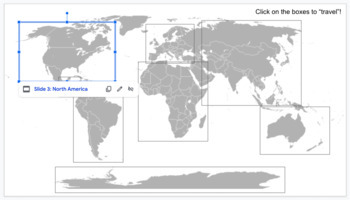Renewable Energy Around the World: Interactive Map & Research Activity
- Google Slides™
- Internet Activities
- Webquests

Description
With this Google Slides activity, students will conduct research about various renewable energy resources used in 8 different regions of the world. The first slide of this slideshow is an interactive map of the world; the 8 regions are clickable, directing students to more region-specific information. On the region-specific slides, students choose from articles provided or research their own about energy generation from renewable resources in specific countries in that region and summarize the information on a slide for each of the 8 regions. This assignment can be assigned asynchronously as homework or used synchronously as a jigsaw, group, or individual classwork or substitute activity. Individual students can present their slide to teach their classmates or complete the slide deck independently as a method of assessment.
This product will expose students to how different countries think about and utilize energy generation methods as well as building confidence in global geography using the interactive map.
This lesson can be given for distance learning or in-person learning and would be suitable for homework or one day of classwork.
For more renewable energy activities, check out EnvironmentLA’s Game of Thrones Renewable Energy Map Activity.




